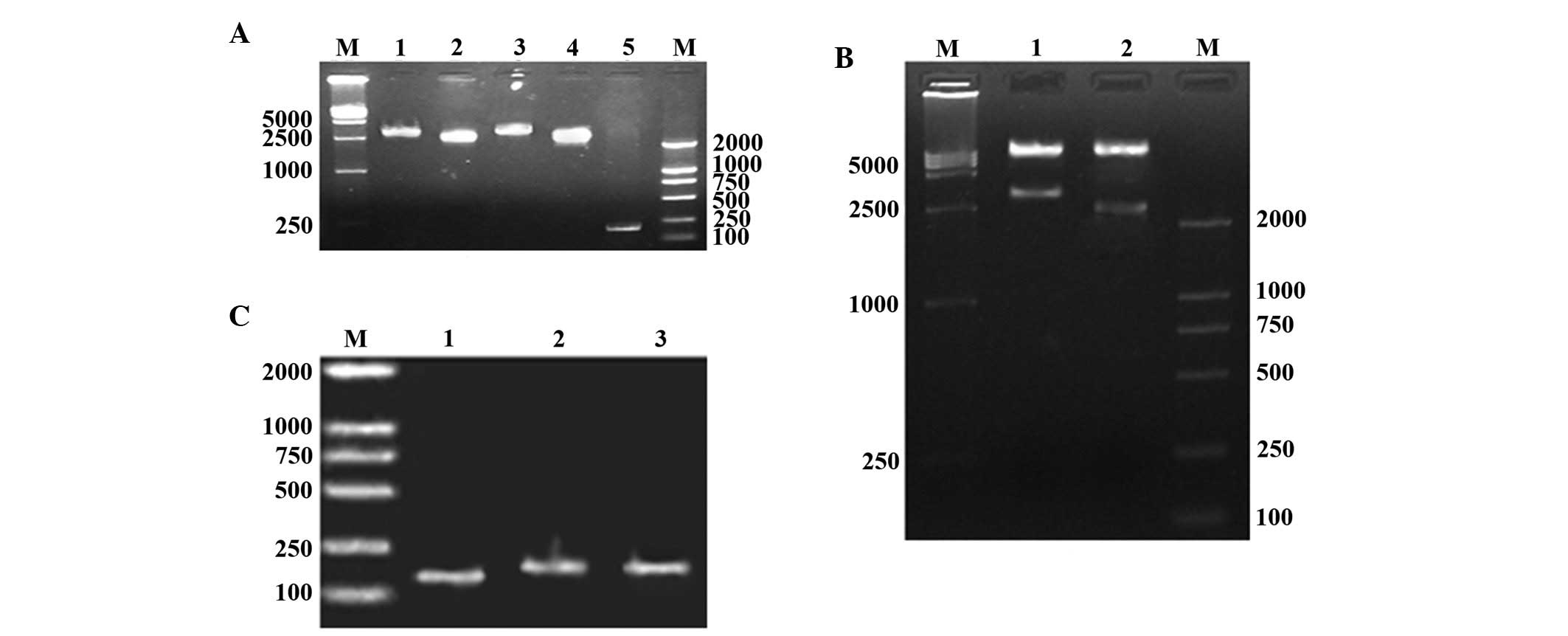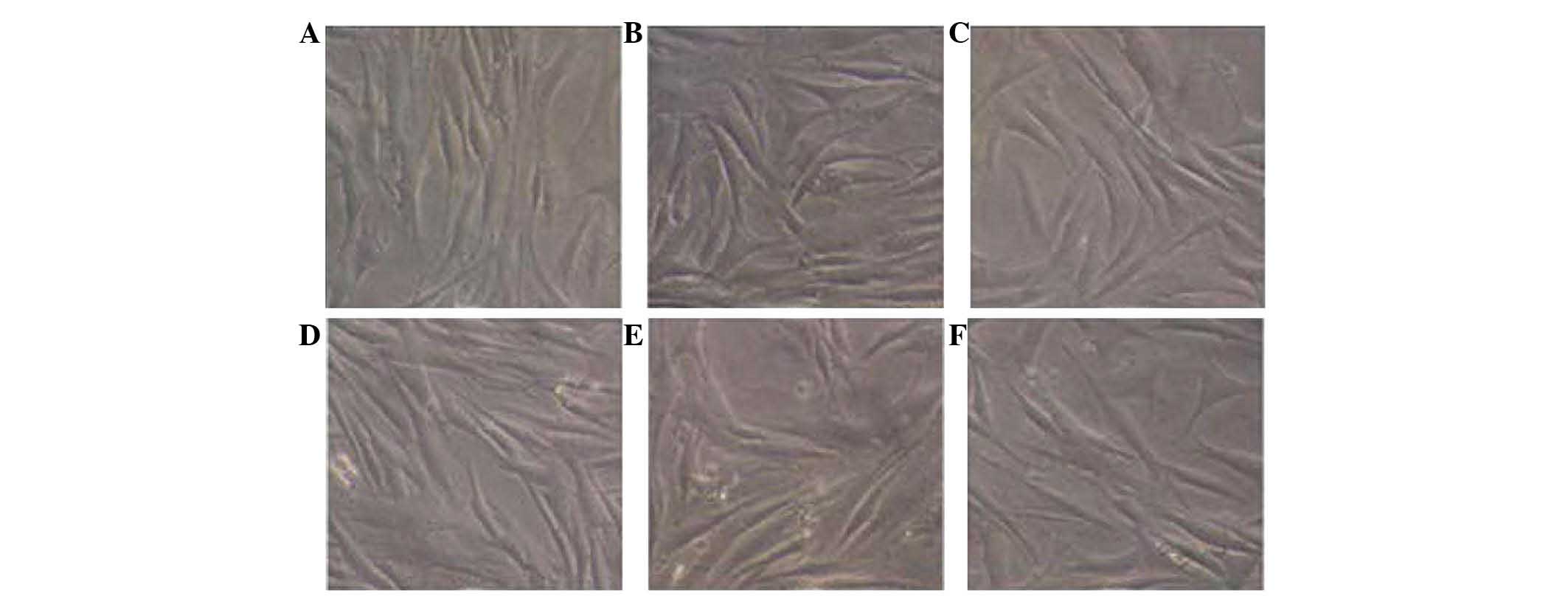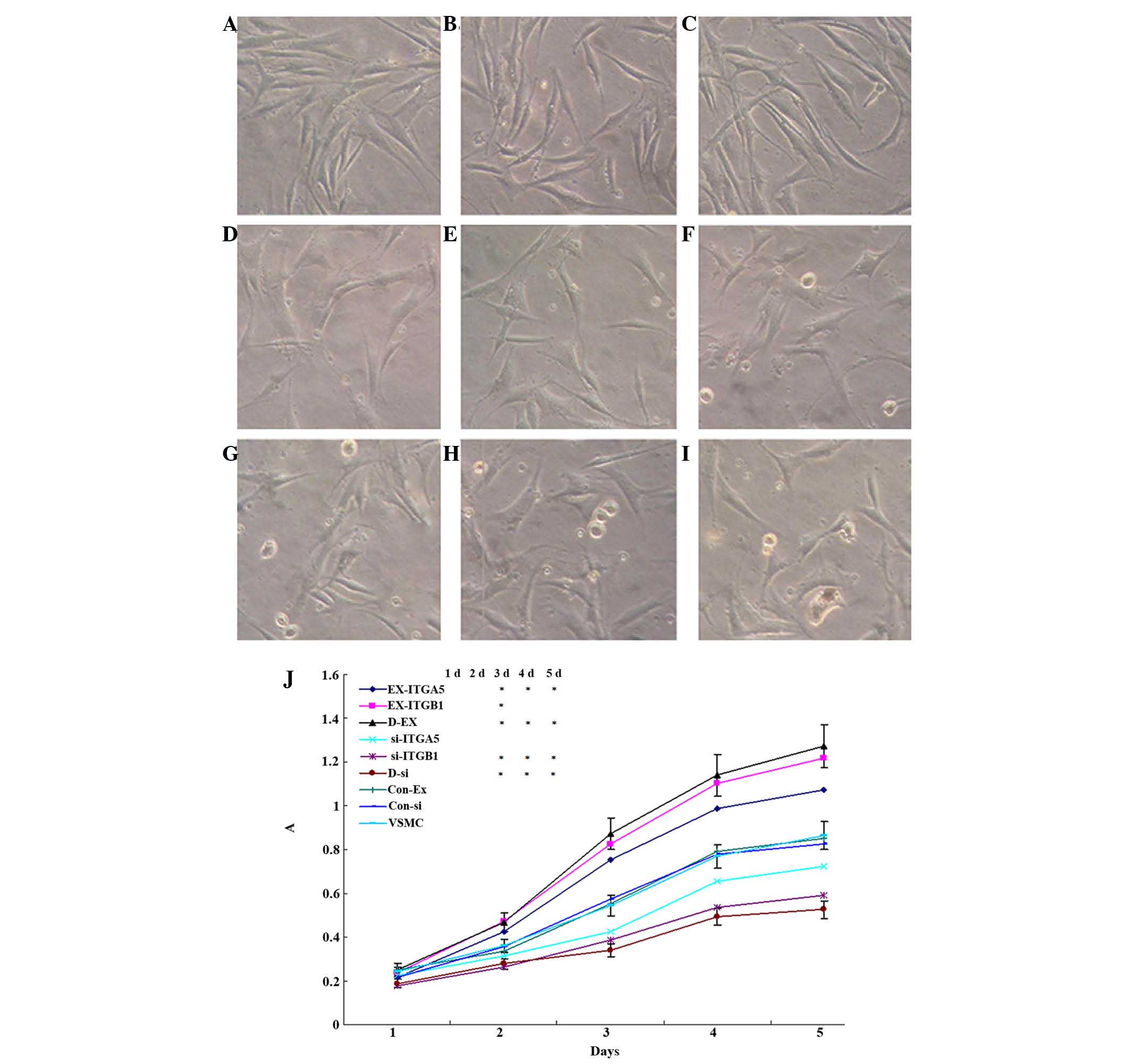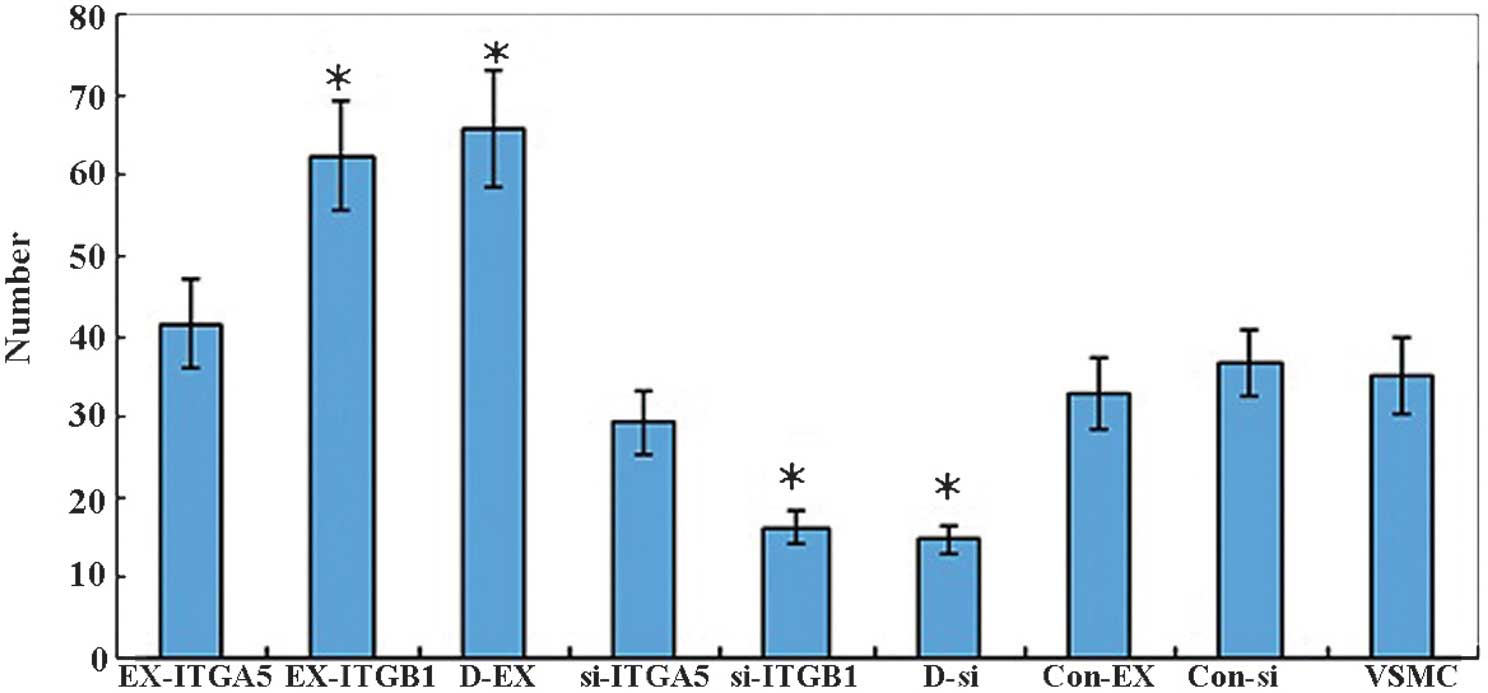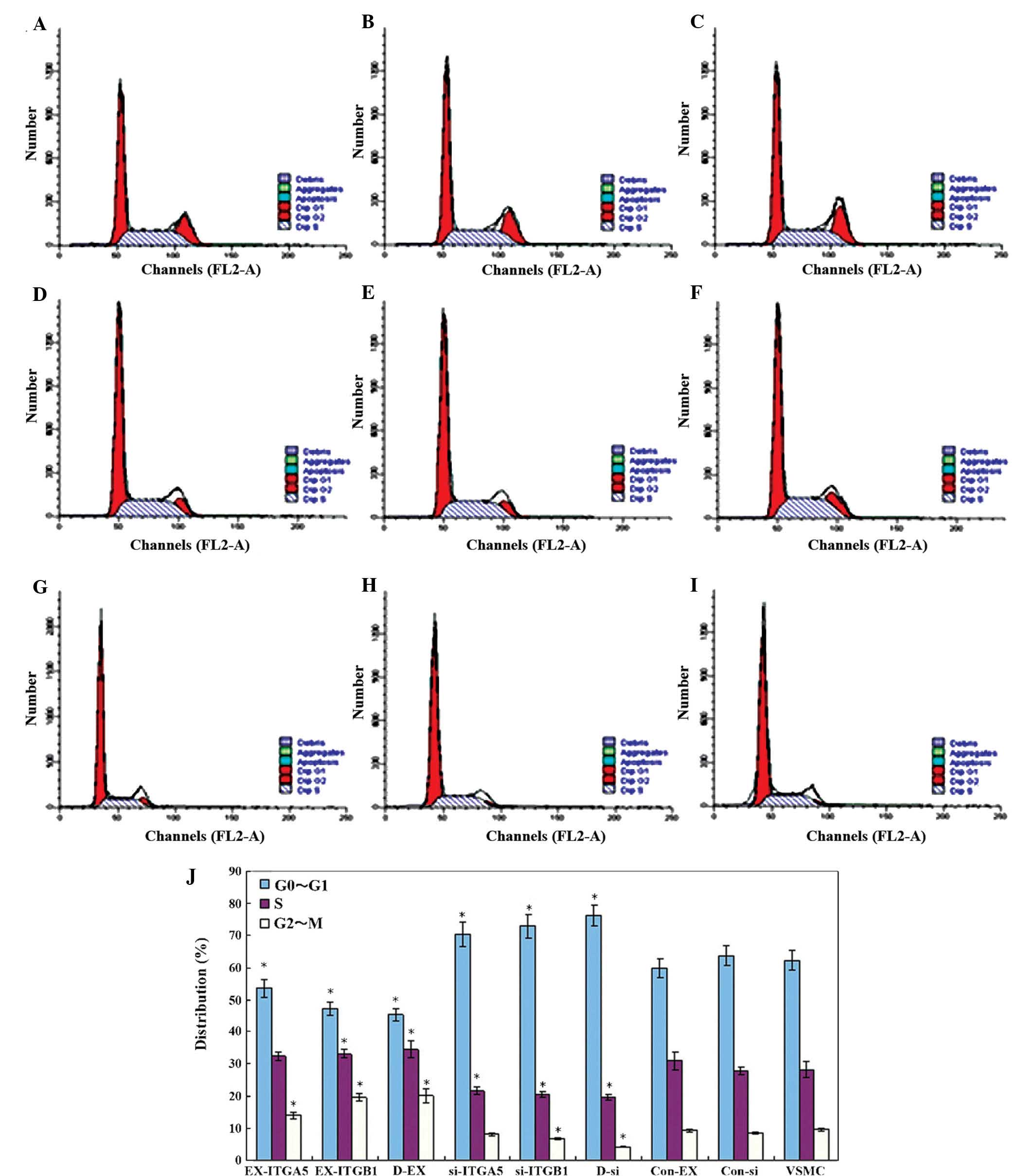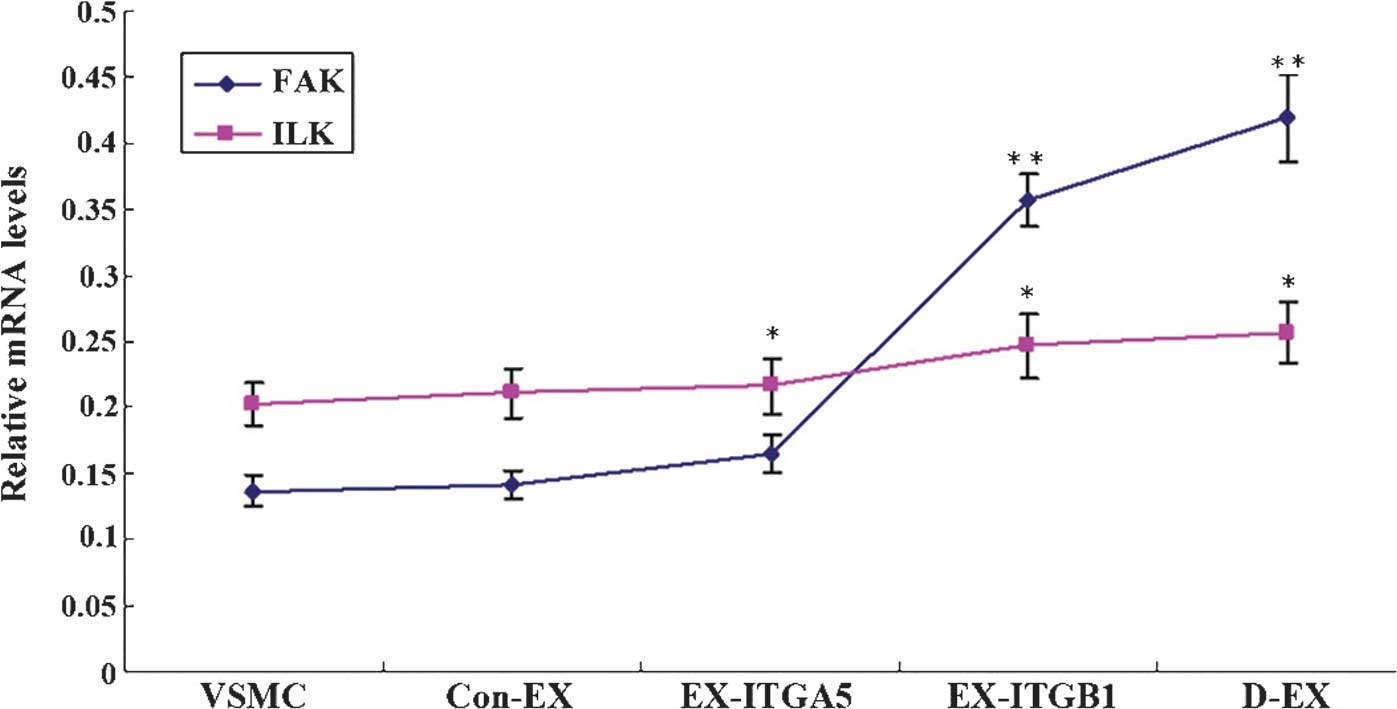Effects of integrin α5β1 on the proliferation and migration of human aortic vascular smooth muscle cells
- Authors:
- Published online on: December 7, 2015 https://doi.org/10.3892/mmr.2015.4649
- Pages: 1147-1155
-
Copyright: © Song et al. This is an open access article distributed under the terms of Creative Commons Attribution License.
Abstract
Introduction
Proliferation and migration of vascular smooth muscle cells (VSMCs) from the tunica media to the tunica intima is an early event in response to vascular injury, including atherosclerosis and angioplasty-induced restenosis (1). Interactions between the cells and surrounding extracellular matrix (ECM) have important roles in numerous cellular processes, including differentiation, proliferation, migration, cytoskeletal organization and survival (2). Fibronectin is an extracellular glycoprotein that has important roles in cell adhesion, migration, growth and differentiation (3). Integrin (ITG) α5β1 is a dominant fibronectin receptor comprised of the α5 and β1 subunits, which is known to be abundantly expressed on the surface of VSMCs (4). ITGβ is able to activate signaling pathways, including the focal adhesion kinase (FAK), Src and Ras/extracellular signal-regulated kinase (ERK) pathways, which are dependent on the interactions between various extracellular matrix (ECM) proteins and ITG (5). FAK and its autonomously expressed C-terminal inhibitor FAK-related non-kinase (FRNK), are important regulators of VSMC spreading and migration (6). Integrin-linked kinase (ILK) is a downstream mediator of ITGβ1 activity. ILK activity has previously been shown to be associated with numerous cell functions (7). It has previously been suggested that ILK has a role in the cell adhesion, proliferation, migration, matrix remodeling and survival of various types of tissue and cells (7).
The role of ITG α5β1 in the proliferation and migration of VSMCs has not yet been reported. The present study aimed to explore the regulatory effects of ITG α5β1 on the proliferation and migration of VSMCs, investigate alterations to the FAK and ILK signaling pathways and understand the underlying mechanisms. The present study constructed a lentiviral expression vector of ITGα5β1 as well as a small interfering RNA (siRNA) lentiviral vector of ITGα5β1 in order to obtain VSMC with ITGα5β1 overexpression and knockdown, respectively. The proliferation, migration, cell cycle distribution and mRNA expression levels of transfected VSMCs were then analyzed.
Materials and methods
Reagents
Fetal bovine serum (FBS) and RPMI 1640 were purchased from Gibco (Thermo Fisher Scientific, Waltham, MA, USA). Trypsin was obtained from HyClone (GE Healthcare, Logan, UT, USA). RNase and propidium iodide (PI) were obtained from Sigma-Aldrich (St. Louis, MO, USA). pGEM-T vector was purchased from Tiangen Biotech Co., Ltd. (Beijing, China). The lentiviral expression vector pLenti, and lentivirus packaging plasmids pLP1 and pLP/VSVG were a generous gift from by Dr Huijun Zhi (Department of Microbiology and Immunology, Uniformed Services University of the Health Sciences, National Institutes of Health, Bethesda, MA, USA). pCMV-SPORT6-ITGα5 and pCMV-SPORT6-ITGβ1 were purchased from OriGene Technologies, Inc. (Rockville, MD, USA). The plasmid pRNAT-U6.2/Lenti was obtained from GenScript (Piscataway, NJ, USA). Restriction enzymes BamHI, XhoI, KpnI and MluI were purchased from Promega Corp. (Madison, WI, USA). Lipofectamine®2000 was purchased from Invitrogen (Thermo Fisher Scientific). ITGα5 mouse monoclonal antibody (cat. no. SC-166681), ITGβ1 monoclonal antibody (cat. no. SC-71386), GAPDH monoclonal antibody (cat. no. SC-137179) and horseradish peroxidase-conjugated goat anti-mouse immunoglobulin G (cat no. SC-2005) were purchased from Santa Cruz Biotechnology, Inc. (Dallas, TX, USA). All antibodies were diluted at a 1:300 ratio and all incubations were performed for 1 h at room temperature. ITGα5 and ITGβ1 reverse-transcription polymerase chain reaction (RT-PCR) kits and primers were purchased from Qiagen China (Beijing, China). The other reagents used in the present study were of analytical grade.
Cell culture
The 293FT cells were obtained from the Shanghai Institute of Cell Biology, Chinese Academy of Sciences (Shanghai, China). The cells were maintained in RPMI 1640 supplemented with 10% FBS. Human aortic VSMCs (no. PCS-100-021) were purchased from the American Type Culture Collection (Manassas, VA, USA) and were cultured in RPMI 1640 supplemented with 10% FBS and antibiotics (100 IU/ml penicillin and 100 µg/ml streptomycin; all from Sigma-Aldrich) at 37°C in a 5% CO2 atmosphere.
Construction of the lentiviral expression vector and siRNA lentiviral vector of ITGα5 and ITGβ1
The entire cDNA sequences of ITGα5 and ITGβ1 were amplified by PCR of pCMV-SPORT6-ITGα5 and pCMV-SPORT6-ITGβ1. The upstream and downstream primers both contained KpnI and MluI endonuclease sites. The cDNA was then ligated with the pGEM-T vector. The ligation products were transfected into Escherichia coli DH5α cells (Beijing Hua Yueyang Biotechnology Co. Ltd., Beijing, China), which were maintained at 37°C. The positive recombinant clones pGEM-T-ITGα5 and pGEM-T-ITGβ1 were then selected and maintained in LB medium for 4 h at 37°C. Subsequently, 1 µl bacterial medium was used as a template and PCR was performed using the EconoTaq PLUS 2X Master Mix (Lucigen, Madison, WI, USA) with T7 (5′-TAATACGACTCACTATAGGGAGA-3′) and SP6 (5′-CATACGATTTAGGTGACACTATAG-3′) primers according to manufacturer's instructions. The positive clones were subjected to DNA sequencing by Shanghai Sengong Biotech (Shanghai, China). The cloning vector and the lentivirus were cut using KpnI and MluI restriction endonucleases, following which they were ligated and transfected. Enzyme analysis and gene sequencing analysis were used to verify the accuracy of the recombinant vectors pLenti-ITGα5 and pLenti-ITGβ1.
According to the nucleotide sequence of the ITGα5 and ITGβ1 genes in GenBank (http://www.ncbi.nlm.nih.gov/genbank/) and the principles of siRNA design, two segment sequences were selected from each: 735–753 nt and 970–988 nt, and 600–618 nt and 1,283–1,301 nt, respectively. The effective siRNA sequences targeting ITGα5 and ITGβ1 were then designed using the siRNA Designer web tool from Promega Corp. and synthesized by Sengong Biotech. The full list of siRNAs and their sequences used in the present study is shown in Table I. Both ends of the hairpin target sequences contained BamHI and XhoI endonuclease sites. The cDNA containing both the sense and antisense strands of the targeting sequence was designed, synthesized and cloned into the pRNAT-U6.2/Lenti vector, which contained the H1 promoter and green fluorescent protein (GFP). The resulting lentiviral vectors containing ITGα5 or ITGβ1 siRNA were named pRNAT-U6.2/Lenti-si ITGα5-1, pRNAT-U6.2/Lenti-siITGα5-2, pRNAT-U6.2/Lenti-siITGβ1-1 and pRNAT-U6.2/Lenti-siITGβ1-2. Restriction endonuclease digestion and DNA sequencing were conducted to confirm the generation of the recombinant vectors. PCR and gene sequencing analysis were used to verify the accuracy of the recombinant vectors.
Lentivirus packaging plasmid mixtures containing Lentivirus-ITGα5 or Lentivirus-ITGβ1, or pRNAT-U6.2/Lenti-siITGα5-1, pRNAT-U6.2/Lenti-siITGα5-2, pRNAT-U6.2/Lenti-siITGβ1-1 or pRNAT-U6.2/Lenti-siITGβ1-2 were co-transfected into the 293FT cells. All transfections were performed using Lipofectamine 2000 (Invitrogen) according to the manufacturer's instructions. The titer of the viral stock solutions was assessed via quantification of the expression levels of GFP as previously described (8).
VSMC transfection
Recombinant lentiviruses were trans-fected into the VSMCs in order to establish the following cell lines with upregulated and downregulated ITGα5 and ITGβ1 gene expression: Lentivirus-ITGα5, Lentivirus-ITGβ1, pRNAT-U6.2/Lenti-siITGα5-1, pRNAT-U6.2/Lenti-siITGα5-2, pRNAT-U6.2/Lenti-siITGβ1-1, pRNAT-U6.2/Lenti-siITGβ1-2, pLentiGFP empty vector and pRNAT-U6.2/Lenti empty. Lipofectamine 2000 (Invitrogen) was used for all transfections according to the manufacturer's instructions. Screening with G418 (Sigma-Aldrich) was used to obtain stably transfected VSMCs. The transfected VMSC cell lines were named: ITGα5-overexpressing cell line (EX-ITGα5), ITGβ1-overexpressing cell line (EX-ITGβ1), ITGα5-knockdown cell line (si-ITGα5), ITGβ1-knockdown cell line (si-ITGβ1), pLentiGFP empty vector-transfected cell line (Con-Ex) and pRNAT-U6.2/Lenti empty vector-transfected cell line (Con-si), respectively. Post-transfection, lentivirus-ITGα5 was trans-fected into the EX-ITGβ1 cell line in order to generate a cell line overexpressing both ITGα5 and ITGβ1 - this cell line was named D-EX. In addition, pRNAT-U6.2/Lenti-siITGα5-1 was transfected into the si-ITGβ1-2 cells in order to generate a cell line exhibiting both ITGα5 and ITGβ1 knockdown - this cell line was named D-si. Quantitative (q-PCR) and western blotting were used to detect the changes to ITGα5 and ITGβ1 gene and protein expression levels in all of the stably transfected cell lines (4,9). Cell growth was observed using microscopy (Inverted microscope IX83; Olympus, Japan).
Proliferation assay
All experiments were conducted using the nine cell lines: EX-ITGα5, EX-ITGβ1, D-EX, si-ITGα5, si-ITGβ1, D-si, Con-Ex, Con-si and normal VSMCs. The nine cell lines were divided into three groups: Overexpressing groups, including EX-ITGα5, EX-ITGβ1 and D-EX; knockdown groups, including si-ITGα5, si-ITGβ1 and D-si; and control groups, including Con-Ex, Con-si and normal VSMCs.
All of the cell lines were cultured in 96-well microtiter plates (Corning, Inc., Corning, NY, USA) at 1×104 cells/well and incubated for five days at 37°C. Subsequently, 20 µl MTT (5 mg/ml; Jiemei Gene Pharmaceutical, Shanghai, China) was added to each well and incubated for 4 h at 37°C. Following removal of the supernatant, 150 µl dimethyl sulfoxide (Jiemei Gene Pharmaceutical) was added to each well, and the absorbance values were measured using a microplate reader (iMark™ Microplate Absorbance reader; Bio-Rad Laboratories, Inc., Hercules, CA, USA) at 490 nm (9).
Migration assay
The migration assay was performed using a Transwell system, which allows cells to migrate through an 8-µm pore polycarbonate membrane in a millicell (10,11). Briefly, the cells were serum-starved for 24 h and then plated (1×104 cells/well) in serum-free medium (Gibco) in the upper chamber of a 24-well Transwell plate (Corning). The lower chamber was filled with 1.5 ml medium supplemented with 500 µl chemotactic factor (Jiemei Gene Pharmaceutical). After 48 h, the cells that remained on the upper surface of the membrane were removed using a cotton swab, and the cells on the lower surface of the membrane were fixed with cold methanol for 15 min and stained with 0.2% crystal violet (Jiemei Gene Pharmaceutical). The cells that had migrated to the bottom of the membrane were visualized and counted using an inverted microscope. For each repetition, cells in four randomly selected fields were counted and averaged. Results were expressed as a ratio of the untreated group.
Cell cycle analysis
The cells were cultured in six-well culture plates for 24 h and incubated for a further 24 h in serum-free medium. The cells were then incubated in medium containing serum for another 48 h. The cell cycle was assessed according to the intensity of PI staining, as described previously (12). Briefly, ethanol-fixed cells were centrifuged and washed twice with phosphate-buffered saline. Subsequently, cells were treated with 100 µl RNase (Promega) for 30 min at 37°C, followed by the addition of 100 µl propidium iodide dye (1 µg/m;l Sigma-Aldrich) and incubation for 30 min in the dark. Cell cycle analysis was performed using a flow Cytometer (FACS Aria II; BD Biosciences, Franklin Lakes, NJ, USA). Data were analyzed using Modfit LT software, version 3.2 (BD Biosciences).
RT-qPCR
Total RNA was isolated using a Total RNA Extraction kit (Qiagen, Hilden, Germany). Total RNA was then reverse-transcribed in a 20-µl reaction solution containing Revert AID™ First Strand cDNA Synthesis kit (Fermentas; Thermo Fisher Scientific). The subsequent RT-qPCR, used to determine the expression levels of ILK and FAK, was conducted as described previously (13,14). The sequences of the individual pairs of ILK, FAK, ITGα5, ITGβ1 and GAPDH primers (Qiagen) are presented in Table II. The PCR reactions were performed using the ABI StepOne Plus PCR system (Applied Biosystems; Thermo Fisher Scientific) in 96-well reaction plates. The thermocycling conditions were as follows: 95°C for 10 min followed by 95°C for 10 sec and 60°C 60 sec for 40 cycles. Gene expression was quantified by 2−ΔΔCT method (15). Relative mRNA levels for each gene were normalized, and values are expressed as the ratio of target gene mRNA to GAPDH expression.
Statistical analysis
Values are expressed as the mean ± standard deviation. Statistical analyses of differences between the groups were performed using Student's t-test and analysis of variance. SPSS 17.0 (SPSS, Inc., Chicago, IL, USA) was used for all statistical analyses. P<0.05 was considered to indicate a statistically significant difference.
Results
Construction of overexpression and RNAi vectors
The results of PCR, enzyme analysis and DNA sequencing analysis confirmed that the ITGα5 and ITGβ1 genes had been successfully cloned (full length, 3,150+176 bp and 2,397+176 bp, respectively), and the pGEM-T-ITGα5 and pGEM-T-ITGβ1 recombinant clones were confirmed by gene sequencing analysis. Enzyme analysis and gene sequencing indicated that the lentiviral expression vectors Lentivirus-ITGα5 and -ITGβ1 had been successfully constructed. PCR and DNA sequencing demonstrated that the lentivirus RNAi vectors psiRNA-ITGα5 and -ITGβ1 were also successfully constructed (Fig. 1). The resulting lentiviral vectors were named pRNAT-U6.2/Lenti-siITGα5 and pRNAT-U6.2/Lenti-siITGβ1. The viral titers were all >7.7×105 IU/ml, and were determined by detecting the expression levels of GFP.
Confirmation of transfected cell lines
As shown in Fig. 2A, the mRNA expression levels of ITGα5 and ITGβ1 were measured by RT-qPCR. The expression levels in the control groups were as follows: Con-si, ITGα5 mRNA (0.252±0.026) and ITGβ1 mRNA (0.516±0.056); Con-Ex, ITGα5 mRNA (0.251±0.021) and ITGβ1 mRNA (0.505±0.062); and Con, ITGα5 (0.238±0.021) and ITGβ1 (0.471±0.051). There were no significant differences between the expression levels in the control groups (P>0.05). The mRNA expression levels of ITGα5 in the EX-ITGα5 and D-EX cells were significantly increased (P<0.05), and were significantly decreased in the si-ITGα5-1 and D-si cells (P<0.05), as compared with those in the control groups. In addition, the mRNA expression levels of ITGβ1 in the EX-ITGβ1 and D-EX cells were significantly increased (P<0.05), while being significantly decreased in the si-ITGβ1-1 and D-si cells (P<0.05). The same trend was observed with regards to the protein expression levels of ITGα5 and ITGβ1, as detected by western blot analysis (Fig. 2B). As observed under an inverted microscope, the EX-ITGα5, EX-ITGβ1 and D-EX cells grew faster, as compared with the control cells, which exhibited better cell morphology and were spindle-shaped. The cells of the si-ITGα5, si-ITGβ1 and D-si groups had a similar morphology to that of the control cells; however, their growth rate was slightly slower as compared with that of the control cells (Fig. 3).
Effects of ITGα5 and ITGβ1 on cell growth
Fig. 4 shows the proliferative activity of the cells. There were no significant differences between the control groups, and on the second day there were no significant differences in cell proliferation between any of the groups. From the third day, the absorbance values of MTT were significantly increased in the EX-ITGβ1 and D-EX cells (P<0.05), and were significantly decreased in the si-ITGβ1 and D-Si cells (P<0.05), as compared with those in the control group; however, there was no significant difference between the EX-ITGα5 and si-ITGα5 cells (P>0.05). These results suggested that upregulation of ITGβ1 expression is able to induce cell proliferation, and downregulation of ITGβ1 expression may hinder cell proliferation. By contrast, ITGα5 expression had no effect on proliferation of the cells.
Effects of ITGα5 and ITGβ1 on cell migration
A Transwell chamber migration assay was used to measure the number of cells that passed through an artificial basement membrane (Fig. 5). The numbers of migrated cells in the control groups were as follows: Con-Ex, 32.9±4.4; Con-si, 36.6±4.1; and Con, 35.2±4.7, and there was no statistical difference between them. There was no difference between the number of migrated cells in the EX-ITGα5 (41.5±5.6) and si-ITGα5 (29.3±3.9) groups, as compared with that in the control groups (P>0.05); however, the number of migrated cells in the EX-ITGβ1 (62.3±6.8) and D-EX (65.7±7.2) groups was markedly increased (P<0.05). In addition, the number of migrated cells in the si-ITGβ1 (16.2±2.1) and D-si (14.8±1.7) groups was significantly decreased (P<0.05). These results indicated that ITGβ1 may affect the migratory ability of VSMCs. However, ITGα5 had no effect on VSMC cell migration.
Effects of ITGα5 and ITGβ1 on the cell cycle distribution
The results of the flow cytometric cell cycle analysis showed that, among the three control groups, the proportion of cells in G0/G1, G2/M and S phase were similar (P>0.05; Fig. 6). There was a higher proportion of cells in G0/G1 phase, as compared with that in S phase and G2/M phase. In the EX-ITGα5, EX-ITGβ1 and D-EX groups, the number of cells in G0/G1 phase was lower, whereas the number of cells in S phase was increased compared with that in the control groups. In addition, there was a higher proportion of cells in G0/G1 phase in the si-ITGα5, si-ITGβ1 and D-si groups, and a lower proportion of cells in S and G2/M phase as compared with that in the control groups. These results suggested that upregulation of ITGβ1 expression may be able to induce cell division.
Effects of ITGα5 and ITGβ1 on the mRNA expression levels of ILK and FAK
The expression levels of ILK in the control groups were as follows: Con-Ex (0.142±0.011), Con-si (0.129±0.012) and Con (0.137±0.012), and there were no differences detected between them (P>0.05). The mRNA expression levels of FAK in the EX-ITGβ1 (0.357±0.0194) and D-EX cells (0.419±0.033) were significantly increased as compared with those in the control groups (P<0.01; Fig. 7). The mRNA expression levels of FAK in the si-ITGβ1 (0.054±0.008) and D-si (0.034±0.004) cells were decreased compared with those in the control (P<0.01). There were no marked changes in ILK mRNA expression levels between the groups. These results indicated that ITGβ-1 may be a major regulator of FAK mRNA expression.
Discussion
In the present study, six types of transfected VSMCs were successfully constructed: and ITGα5-overexpressing cell line (EX-ITGα5), an ITGβ1-overexpressing cell line (EX-ITGβ1), an ITGα5- and ITGβ1-overexpressing cell line (D-EX), an ITGα5 knockdown cell line (si-ITGα5), an ITGβ1 knockdown cell line (si-ITGβ1) and an ITGα5- and ITGβ1-knockdown cell line (D-si). A pLentiGFP empty vector cell line (Con-Ex), pRNAT-U6.2/Lenti empty vector cell line (Con-si) and normal VSMC cell line were also used, alongside the six experimental cell lines, to analyze cell cycle distribution, proliferation and migration.
The results of the present study demonstrated that ITGβ1 upregulation was able to induce VSMCs to re-enter the cell division cycle, and increase proliferation and migration. Conversely, downregulation of ITGβ1 resulted in the opposite effect in VSMCs. Furthermore, ITGα5 regulation had no effect on the proliferation and migration of VSMCs. Abnormal proliferation and migration of VSMCs is the main cause of early vascular restenosis (16). Integrins are a family of glycoprotein cell surface receptors that participate in cell adhesion with the ECM, and have an important role in regulating cell growth, differentiation and proliferation. ITG α5β1 is associated with the migration, proliferation and vascular injury repair process of VSMCs (17). The present study compared three cell groups: Overexpressing cells, including EX-ITGα5, EX-ITGβ1 and D-EX; knockdown groups, including si-ITGα5, si-ITGβ1 and D-si; and the control cells, including Con-Ex, Con-si and normal VSMCs. ITGβ1 was shown to be able to positively regulate the proliferation and migration of VSMCs and induce cell division. By contrast, ITGα5 did not have any effect on the functions of VSMCs. These results indicated that ITGβ1 may be involved in the proliferation and migration of VSMCs.
During ITG-mediated proliferation and migration of VSMCs, FAK and ILK were shown to be involved in the signaling pathway. Biochemical evidence has previously suggested that ILK may interact with ITGβ1 as well as ITGβ3 (18). ITGβ1 and the associated ILK have a crucial role in cell survival, tissue homeostasis and carcinogenesis. ILK associates with ITG tails and thereby links ITGs with the actin cytoskeleton and various signaling pathways (19,20). FAK may be the main structural basis for the signal conduction of VSMC proliferation and migration regulation (2). The results of the present study showed that the mRNA expression levels of FAK in the EX-ITGβ1 and D-EX cells were increased, whereas they were decreased in the si-ITGβ1 and D-si cells. However, there were no marked changes in ILK mRNA expression levels. These results suggested that ITGβ1 may be a major regulator of FAK mRNA expression.
In conclusion, the present study investigated the role of ITG α5β1 in the proliferation and migration of VSMCs. ITGβ1 was shown to be involved in the proliferation and migration of VSMCs, and FAK was involved in the signaling pathways of ITGβ1. These results may provide a possible therapeutic target for the prevention and treatment of VSMC-associated early vascular disease.
Acknowledgments
The present study was supported by a grant from the Basic and Advanced Technology Research Projects of Henan Province, China (no. 1223004110184).
References
|
Han M, Wen JK, Zheng B, Liu Z and Chen Y: Blockade of integrin beta3-FAK signaling pathway activated by osteopontin inhibits neointimal formation after balloon injury. Cardiovasc Pathol. 16:283–290. 2007. View Article : Google Scholar : PubMed/NCBI | |
|
Huang S, Sun Z, Li Z, Martinez-Lemus LA and Meininger GA: Modulation of microvascular smooth muscle adhesion and mechanotransduction by integrin-linked kinase. Microcirculation. 17:113–127. 2010. View Article : Google Scholar : PubMed/NCBI | |
|
Ruoslahti E: Fibronectin and its receptors. Annu Rev Biochem. 57:375–413. 1988. View Article : Google Scholar : PubMed/NCBI | |
|
Pickering JG, Chow LH, Li S, Rogers KA, Rocnik EF, Zhong R and Chan BM: alpha5beta1 integrin expression and luminal edge fibronectin matrix assembly by smooth muscle cells after arterial injury. Am J Pathol. 156:453–465. 2000. View Article : Google Scholar : PubMed/NCBI | |
|
Li JJ, Han M, Wen JK and Li AY: Osteopontin stimulates vascular smooth muscle cell migration by inducing FAK phosphorylation and ILK dephosphorylation. Biochem Biophys Res Commun. 356:13–19. 2007. View Article : Google Scholar : PubMed/NCBI | |
|
Koshman YE, Engman SJ, Kim T, Iyengar R, Henderson KK and Samarel AM: Role of FRNK tyrosine phosphorylation in vascular smooth muscle spreading and migration. Cardiovasc Res. 85:571–581. 2010. View Article : Google Scholar : | |
|
Brakebusch C and Fässler R: The integrinactin connection, an eternal love affair. EMBO J. 22:2324–2333. 2003. View Article : Google Scholar : PubMed/NCBI | |
|
Zhang YG, Guo X, Zhou JJ, Yu B and Liu B: Sorting of packaging cells for retroviral vector carrying green fluorescent gene and viral titer determination. Di Yi Jun Yi Da Xue Xue Bao. 25:30–32. 362005.In Chinese. | |
|
Zhou Y, Luo W, Zheng L, Li M and Zhang Y: Construction of recombinant FGFR1 containing full-length gene and its potential application. Plasmid. 64:60–67. 2010. View Article : Google Scholar : PubMed/NCBI | |
|
Adams LS, Phung S, Yee N, Seeram NP, Li L and Chen S: Blueberry phytochemicals inhibit growth and metastatic potential of MDA-MB-231 breast cancer cells through modulation of the phosphatidylinositol 3-kinase pathway. Cancer Res. 70:3594–3605. 2010. View Article : Google Scholar : PubMed/NCBI | |
|
Wang Z, Banerjee S, Li Y, Rahman KM, Zhang Y and Sarkar FH: Down-regulation of notch-1 inhibits invasion by inactivation of nuclear factor-kappaB, vascular endothelial growth factor, and matrix metalloproteinase-9 in pancreatic cancer cells. Cancer Res. 66:2778–2784. 2006. View Article : Google Scholar : PubMed/NCBI | |
|
Zhang Y, Zhang J, Dai B, Wang N and He L: Anti-proliferative and apoptotic effects of the novel taspine derivative tas41 in the Caco-2 cell line. Environ Toxicol Pharmacol. 31:406–415. 2011. View Article : Google Scholar : PubMed/NCBI | |
|
Zhang YM, Dai BL, Zheng L, et al: A novel angiogenesis inhibitor impairs lovo cell survival via targeting against human VEGFR and its signaling pathway of phosphorylation. Cell Death Dis. 3:e4062012. View Article : Google Scholar : PubMed/NCBI | |
|
Zhang Y, Zheng L, Zhang J, Dai B, Wang N, Chen Y and He L: Antitumor activity of taspine by modulating the EGFR signaling pathway of Erk1/2 and Akt in vitro and in vivo. Planta Med. 77:1774–1781. 2011. View Article : Google Scholar : PubMed/NCBI | |
|
Livak KJ and Schmittgen TD: Analysis of relative gene expression data using real-time quantitative PCR and the 2(−Delta Delta C(T)) Method. Methods. 25:402–408. 2001. View Article : Google Scholar | |
|
Shi L, Ji Y, Jiang X, et al: Liraglutide attenuates high glucose-induced abnormal cell migration, proliferation, and apoptosis of vascular smooth muscle cells by activating the GLP-1 receptor, and inhibiting ERK1/2 and PI3K/Akt signaling pathways. Cardiovasc Diabetol. 14(18)2015. View Article : Google Scholar : PubMed/NCBI | |
|
Friedrich EB, Clever YP, Wassmann S, Werner N, Böhm M and Nickenig G: Role of integrin-linked kinase in vascular smooth muscle cells: Regulation by statins and angiotensin II. Biochem Biophys Res Commun. 349:883–889. 2006. View Article : Google Scholar : PubMed/NCBI | |
|
Hannigan GE, Leung-Hagesteijn C, Fitz-Gibbon L, et al: Regulation of cell adhesion and anchorage-dependent growth by a new beta 1-integrin-linked protein kinase. Nature. 379:91–96. 1996. View Article : Google Scholar : PubMed/NCBI | |
|
Böttcher RT, Lange A and Fässler R: How ILK and kindlins cooperate to orchestrate integrin signaling. Curr Opin Cell Biol. 21:670–675. 2009. View Article : Google Scholar : PubMed/NCBI | |
|
Kanasaki K, Kanda Y, Palmsten K, et al: Integrin beta1-mediated matrix assembly and signaling are critical for the normal development and function of the kidney glomerulus. Dev Biol. 313:584–593. 2008. View Article : Google Scholar |



